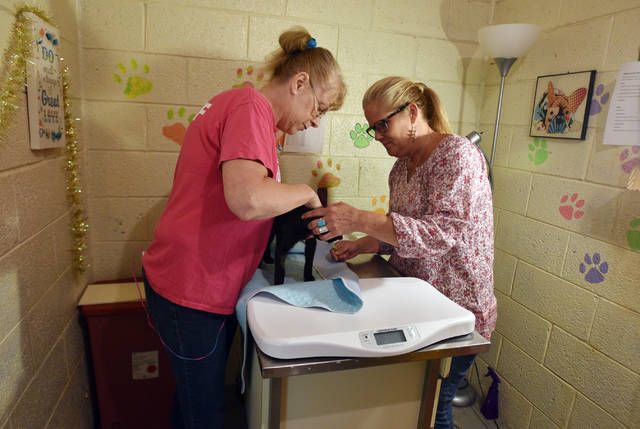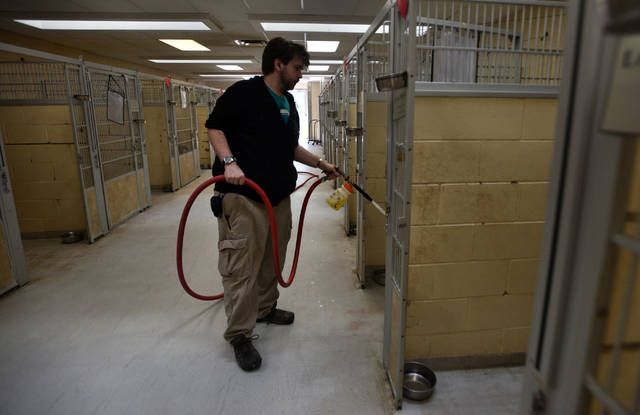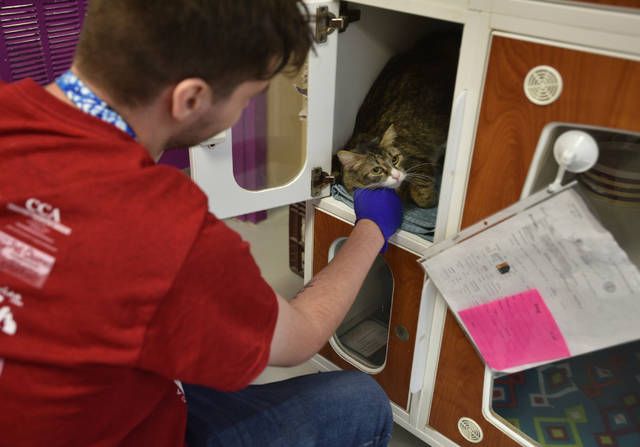Click here to subscribe today or Login.
PLAINS TWP. — Portraits of smiling pit bulls adorn Todd Hevner’s office at the SPCA of Luzerne County.
As a pet owner, Hevner admits they are his favorite breed, and speaks warmly of those he and his wife have loved over many years.
As the SPCA’s executive director, he follows the motto found on one of the murals outside the agency’s East Main Street headquarters: “Rescued is our favorite breed.”
Indeed, many breeds are depicted in the colorful paintings around the building, a hallmark of Hevner’s tenure here.
“We are an adoption center for homeless animals, and we are very proud of that,” Hevner said.
There’s another motto outside the building: “Until they all have homes.”
“Ideally what we would like to do is work ourselves out of business. What a beautiful day that would be when we are just not needed anymore,” Hevner said. “Unfortunately I am a realist, so I do understand that’s likely never to happen.”
Until then, Hevner, his staff of 33 and hundreds of volunteers work tirelessly toward that impossible dream. Most importantly, they work toward educating the public on how to properly care for pets, and how to help reduce the overpopulation that makes shelters like the SPCA necessary.
Hevner, who has been in his current role for three years, sat down with the Times Leader for a lengthy interview last week about what the SPCA does, how overpopulation hurts animals and what it’s like to lead a $1.2 million nonprofit serving a jurisdiction as large and geographically diverse as Luzerne County. It has been edited for length and clarity.
Q: The SPCA has a long history here. How has it evolved over the years?
A: Our shelter started in 1957, and it was founded by a group of concerned citizens. Yes, at one point this was the pound, but we are not the pound that we once were. We are a happy place. We are a respite for animals who don’t always have a home. We are able to provide them with the shelter, food, love and care that we believe they certainly deserve.
Q: Why do we still need shelters at all?
A: The primary reason is the overpopulation of domestic companion animals — cats, dogs, bunnies, fuzzy things, reptiles — you name it.
About half of our population comes in as stray animals, thanks to Good Samaritans.
We also have surrenders here. For whatever reason in their lives, some people are no longer able to care for their pets in a responsible manner. So they reach out to us to see if we care for their animal and find it a new forever home.
And finally, there are the humane cases. We have three full-time humane officers who service our county, and they are charged with upholding Pennsylvania anti-cruelty laws. As a result of that, we will seize animals if they are not being cared for according to the law.
Q: How large is your population?
A: We largely operate at capacity almost daily. At any given point, we have 150 cats and between 50 and 70 dogs. Our population of small animals varies from time to time.
Q: Your mission is broader than just operating as a shelter, right?
A: Our mission is three-fold. It is humane law enforcement, it is sheltering and it is education.
Q: What do you mean by education?
A: We educate our community on a near-daily basis — whether it’s our humane educator in schools talking with children, and educating them on the responsibilities of pet ownership and the importance of spaying and neutering, or educating people about laws related to pets. Or we’re in this office, educating new adopters.
Q: Going back to overpopulation, spaying and neutering is a major theme here, isn’t it?
A: We sing it from the mountaintops and hope we are connecting at least with a few individuals, because it is really the answer to our problems.
Access to affordable spay-neuter helps us to whittle down the populations that need to stay in this shelter. We operate a low-cost spay-neuter clinic. Right now it is solely for indoor cats, but we also partner with two other organizations — one that handles outside cats and one that handles both cats and dogs. We really have tried to make the process of spay-neuter accessible, affordable and remove the inconvenience.
Q: What are some of the consequences of not embracing spay-neuter?
A: Feral cats are a problem in our community and they know no boundaries. This isn’t a city problem, this is a Luzerne County problem. From our urban streets to our countryside, there are feral cats everywhere. It can get out of hand and overwhelming in no time.
I would venture to guess there are thousands in our county. For every restaurant that has a dumpster out back you can guess there is at least one feral cat — more likely four, five, 10, 20 — that are feeding out of that dumpster. And you’ll never see them. They are savvy critters in survival mode, and they come out at night and you’ll never see them.
Personal pets thrive in our homes, but the life of a feral cat can be a tough life, and it unfortunately means a rather short life. Statistically, at best a feral cat will live between three and five years. Wild animals, neighbors that take matters into their own hands, cars, it just is a life of survival, not one of thriving.
Q: That overpopulation also has consequences for the SPCA. You euthanize here, right?
A: Yes. It is a hot-button issue, and one this shelter has dealt with from its inception.
Euthanasia is an ugly tool that is used sometimes to control overpopulation, but you have to. The reality is we take in nearly 5,000 animals every year. We do not have the ability to care for that many animals. Until we as a community embrace spay-neuter, the use of euthanasia will always be a necessary evil.
Q: How many animals does the SPCA euthanize?
A: We probably hover somewhere in the low 40s (percent of those brought in), and the bulk of those are feral cats. It is higher than I’d like, but not nearly as high as our community thinks.
Q: The SPCA also strongly promotes adoption of rescued animals. How does that process work?
A: It starts here at our shelter with an application. It gathers some basic information on the individual and their intent, as well as their history with animals.
There’s a nominal fee for our adoptions. Our cats are $65, our dogs are $120. They come micro-chipped, inoculated, sterile and a with a basic health and welfare check from our veterinarian. It truly is the best value going when you’re looking for an animal. These guys are looking for a home, and they are coming with all the things we would recommend for responsible pet ownership.
Q: Why adopt vs. shop?
A: Because there’s no shortage of homeless animals. You have a shelter in your community that is a lot of times operating at capacity and needs the support of the community to address this problem.
* * *
DON’T MISS Monday’s edition for the second part of our interview with the SPCA’s Todd Hevner.







